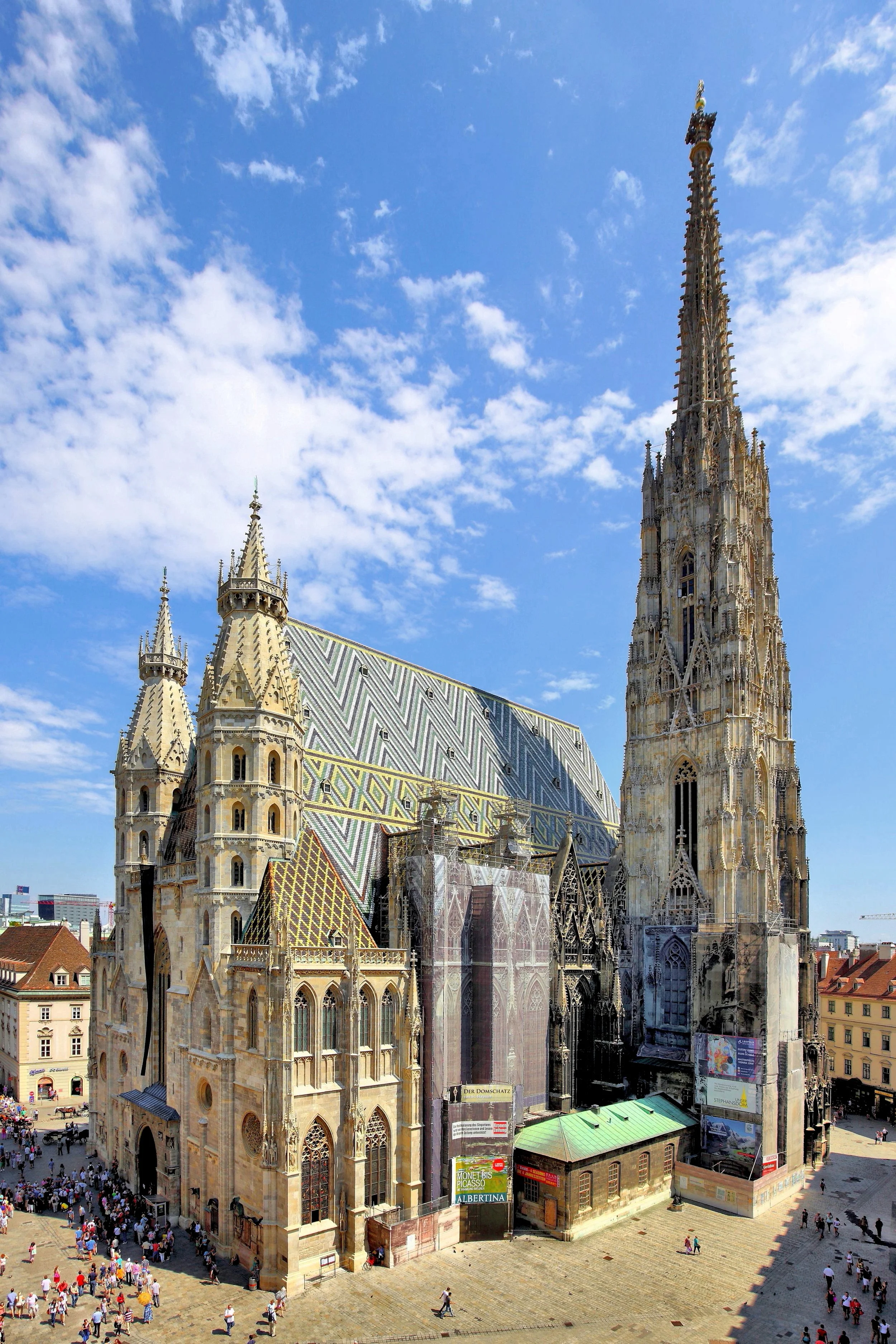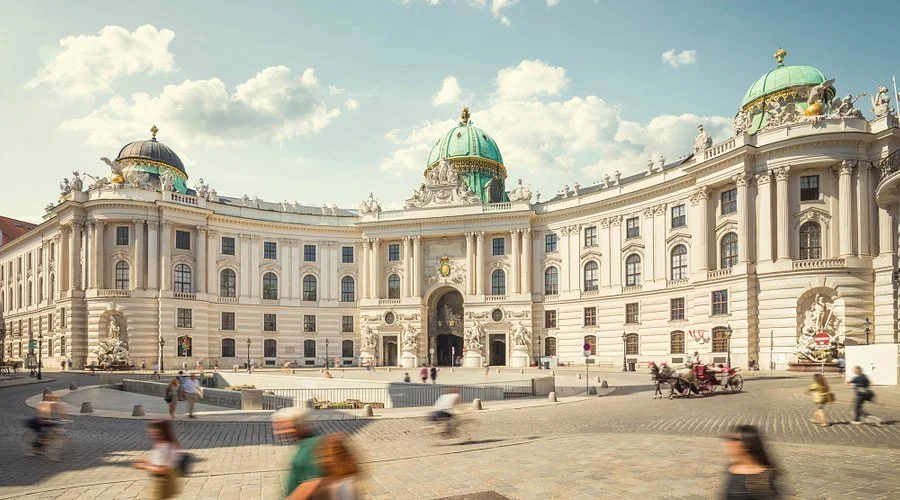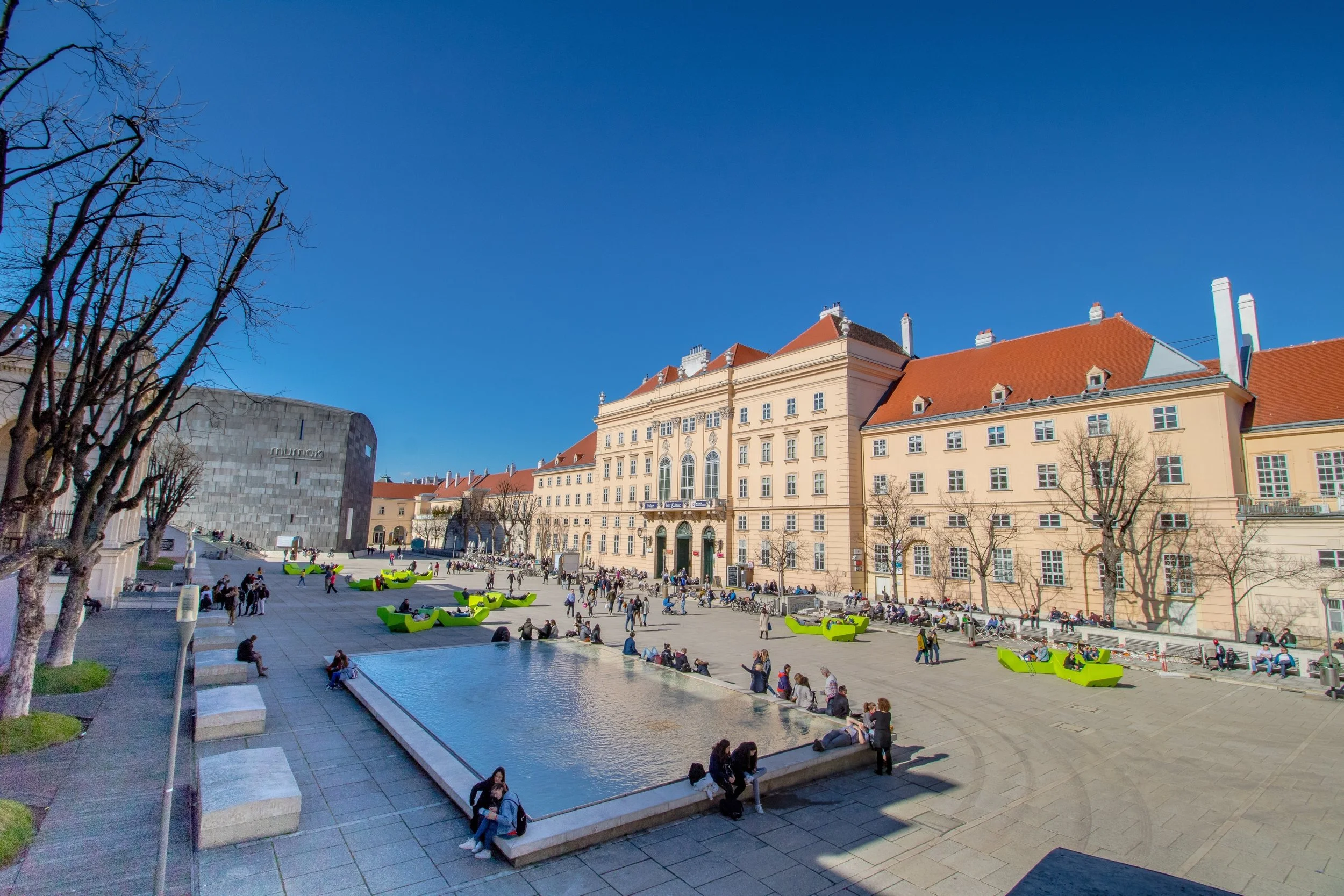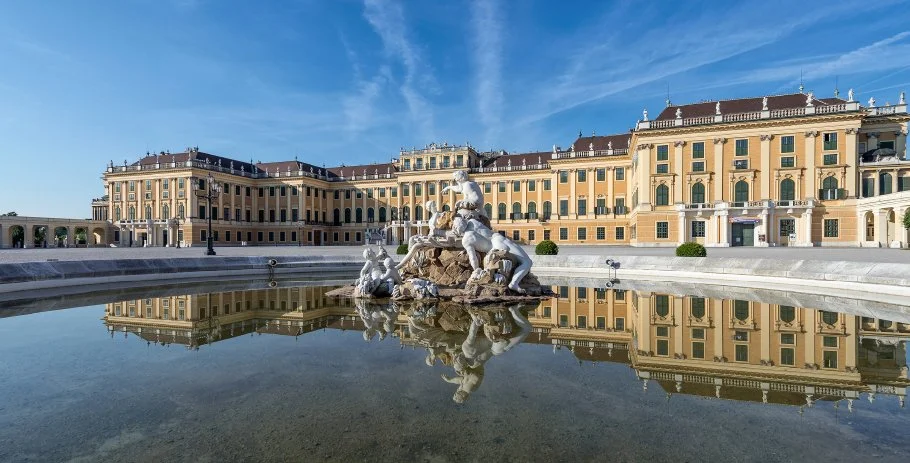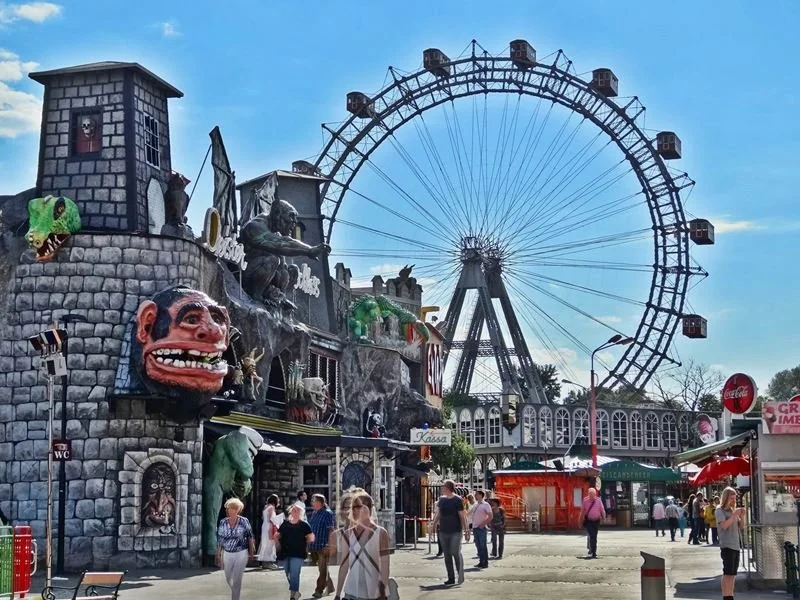VIENNA
Vienna, the city of imperial grandeur and timeless elegance, is a place where history and modern life harmoniously intertwine. Known as the city of music, it was home to Mozart, Beethoven, and Strauss, and still resonates with the sound of classical concerts in magnificent halls. Vienna is also the city of coffeehouse culture, where elegant cafés invite you to linger over rich coffee and decadent pastries. Stroll through palaces, museums, and vibrant streets, or relax in lush parks along the Danube. Vienna enchants every visitor with its unique blend of art, tradition, and contemporary charm.
1. St. Stephans Cathedral
Right in the heart of Vienna, St. Stephen’s Cathedral is the city’s most famous landmark and a must-see for visitors. The Gothic masterpiece, with its colorful tiled roof and soaring South Tower, has stood for more than 700 years as a symbol of Vienna.
Opening times: The church itself is open daily from early morning until late evening for prayer. Sightseeing visits are usually possible Monday–Saturday 9:00–11:30 and 13:00–16:30, and Sundays/public holidays 13:00–16:30 (times may vary during services).
Tickets & highlights: Entry to the main nave is free. For a deeper experience, visitors can join a guided cathedral tour (€7), descend into the historic catacombs (€7), or climb the South Tower’s 343 steps (€6.50) for breathtaking views across Vienna. The North Tower is accessible by lift (€7) and houses the famous Pummerin bell. A combination ticket (~€25) also includes the Dom Museum, showcasing sacred art and treasures.
Tips: Bring some cash as smaller ticket counters may not accept cards. If you plan to explore several areas, a combo ticket offers the best value.
Whether you’re interested in history, art, or simply enjoying the views, St. Stephen’s is an unforgettable stop in Vienna.
2.The Imperial Palace (HofBurg)
The Hofburg, once the winter residence of the Habsburg dynasty, is today one of Vienna’s most impressive cultural landmarks. Located in the city center, the sprawling palace complex reflects over 600 years of history and now houses museums, the Austrian National Library, the Imperial Chapel, and the Spanish Riding School.
Opening times: Most museum areas are open daily, generally from 9:00–17:30 (July–August often until 18:00). The Spanish Riding School and Chapel have separate schedules for performances and services.
Tickets & highlights:
Imperial Apartments, Sisi Museum & Silver Collection (~€16–19 adults) – a journey into the private life of Emperor Franz Joseph and Empress Elisabeth (“Sisi”).
Spanish Riding School – morning training sessions and gala performances featuring the famous Lipizzaner horses.
Imperial Treasury (~€14 adults) – home to the Austrian crown jewels, including the Imperial Crown of the Holy Roman Empire.
Austrian National Library (~€10 adults) – one of the world’s most beautiful baroque libraries.
Tips: Combo tickets are available if you’d like to visit multiple sections. Allow at least half a day to explore, as the Hofburg is vast and varied.
The Hofburg is not just a palace but a living piece of Austrian history, offering art, culture, and imperial glamour in the heart of Vienna.
3. Museumsquaters
The MuseumsQuartier (MQ) is Vienna’s cultural heart, combining baroque grandeur with striking modern architecture. It’s one of the world’s largest art and culture complexes, with museums, cafés, and lively courtyards that invite you to linger.
In the MQ:
Leopold Museum (~€15) – the largest Egon Schiele collection worldwide, plus works by Gustav Klimt.
MUMOK (Museum of Modern Art) (~€15) – Austria’s biggest museum for modern and contemporary art.
Kunsthalle Wien (~€12) – dynamic temporary exhibitions of contemporary art.
ZOOM Kindermuseum – hands-on fun for children.
Across the square (Maria-Theresien-Platz):
Kunsthistorisches Museum (Art History Museum) (~€18) – one of the world’s great art collections, featuring Bruegel, Rubens, Velázquez, and treasures of the Habsburgs.
Natural History Museum (~€18) – from glittering gemstones to dinosaur skeletons, this 19th-century palace of science is as impressive as its exhibits.
Tips: Most museums are open Tuesday–Sunday, 10:00–18:00 (some with late openings on Thursdays). The MQ courtyards are free and open day and night, perfect for relaxing between visits.
4.Burgtheater and Rathausplatz
Facing each other along Vienna’s grand Ringstrasse, the Burgtheater and Rathausplatz form one of the city’s most iconic cultural ensembles.
Burgtheater – Opened in 1888, the Burgtheater is Austria’s national theater and one of the most important stages in the German-speaking world. Its neo-Renaissance façade and richly decorated interiors make it worth a visit even if you don’t attend a performance. Guided tours (approx. €10–12) are offered in English and German, taking you behind the scenes to the grand staircases, Gustav Klimt ceiling paintings, and historic auditorium. Evening performances are held almost daily, with tickets starting at around €10.
Rathausplatz – Directly opposite, Vienna’s City Hall (Rathaus) dominates the square with its striking neo-Gothic towers. The square itself is a lively gathering place that hosts many of the city’s most beloved events: the Christmas Market (November–December), the Vienna Ice Dream skating rink (January–March), and the Film Festival with open-air dining and concerts (July–August). Even outside event season, the Rathaus and its park are a wonderful spot for photos and a stroll.
Tips: Both sites are easy to reach by tram or U-Bahn (station “Rathaus”). If you have limited time, pair them with a Ringstrasse walk to see Vienna’s grand boulevard architecture.
5.Belvedere Castle
The Belvedere is one of Vienna’s most beautiful baroque landmarks, set in elegant gardens that connect the Upper and Lower Belvedere. Built in the 18th century as the summer residence of Prince Eugene of Savoy, today it houses some of Austria’s most important art collections.
Upper Belvedere – The highlight for most visitors, the Upper Belvedere showcases Austrian art from the Middle Ages to the 20th century. Its star attraction is Gustav Klimt’s “The Kiss”, along with works by Schiele, Kokoschka, Monet, and Van Gogh. Tickets are around €17–19 for adults.
Lower Belvedere – Originally the prince’s residential palace, it now hosts major temporary exhibitions. Visitors can admire the opulent staterooms, the Marble Hall, and the Golden Cabinet. Tickets are around €15–17 for adults.
Belvedere 21 – A modern addition nearby, this museum focuses on contemporary art, architecture, and film.
Tips: The palace gardens are free to enter and open daily from early morning until evening, making them a lovely place for a stroll. Most museum spaces open daily from about 10:00–18:00 (some longer hours on Thursdays). Combination tickets are available if you plan to visit both Upper and Lower Belvedere.
The Belvedere combines art, history, and stunning views of Vienna in one unforgettable visit.
6.Naschmarkt
tretching for more than a kilometer along Wienzeile, the Naschmarkt is Vienna’s most famous open-air market and a lively mix of flavors, colors, and cultures. With roots going back to the 16th century, it’s a favorite for both locals and visitors looking to taste the city’s culinary diversity.
What to find: Around 120 permanent stalls and restaurants offer everything from fresh fruit, vegetables, cheese, and spices to international specialties, sushi, Middle Eastern dishes, and Viennese classics. It’s an ideal spot for a quick snack, a casual lunch, or a relaxed dinner. The surrounding eateries come alive in the evenings, especially during warmer months.
Market hours:
Food stalls: Monday–Saturday, roughly 6:00–18:00.
Restaurants and bars often stay open later into the evening.
On Saturdays, the adjacent flea market is a highlight, offering antiques, vintage treasures, and quirky finds from early morning until mid-afternoon.
Tips: The Naschmarkt can get crowded, especially on Saturdays—come early if you’d like to shop peacefully. Prices vary from bargain produce to upscale dining, so there’s something for every budget. The market is easily reached by U4 metro (station “Kettenbrückengasse”).
Whether you’re in the mood to shop, taste, or simply soak up the atmosphere, the Naschmarkt is one of Vienna’s liveliest meeting points.
7.Operahouse
The Vienna State Opera is one of the world’s leading opera houses and a symbol of the city’s musical heritage. Opened in 1869 with a performance of Mozart’s Don Giovanni, it continues to impress with its grand architecture and world-class productions.
Performances: The Staatsoper stages over 300 performances each season, with a repertoire ranging from Mozart and Verdi to contemporary works. Ticket prices vary widely – from standing room tickets for as little as €4–10, to premium seats that can cost several hundred euros. Performances usually start in the evening (19:00), with occasional matinees.
Guided tours: Even if you don’t attend an opera, guided tours (around €13–15 adults, available in English and several languages) give access to the grand staircase, auditorium, tea salon, and backstage areas, offering a glimpse behind the scenes. Tours last about 40 minutes and run several times a day.
Tips: Standing room tickets are sold at a special counter shortly before each performance and are a beloved Viennese tradition. Dress codes are smart but not overly formal (except for gala nights). The opera house is located on the Ringstrasse, next to the Kärntner Strasse shopping street and Albertina Museum.
Visiting the Staatsoper is a chance to experience Vienna’s passion for music and one of the finest opera houses in the world.
8.Albertina
The Albertina is one of Vienna’s most important art museums, housed in a former Habsburg palace just behind the State Opera. Its elegant neoclassical façade and lavish staterooms provide the backdrop for a world-class collection that spans centuries of art history.
Highlights: The Albertina is most famous for its graphic arts collection, with over one million prints and 65,000 drawings, including works by Dürer, Michelangelo, Rembrandt, and Picasso. Visitors usually see rotating exhibitions of these fragile works. The museum also showcases the Monet to Picasso collection – masterpieces of Impressionism, Fauvism, Cubism, and beyond – featuring Monet, Renoir, Degas, Cézanne, Matisse, and Picasso. Temporary exhibitions often bring international blockbusters.
Tickets & hours: Admission is around €18 for adults, with concessions available; children and teens under 19 enter free. The museum is generally open daily 10:00–18:00, with extended evening hours on certain days.
Tips: Don’t miss the restored State Rooms, once used by the Habsburg archdukes. The terrace of the Albertina also offers great views of the Vienna State Opera and Albertinaplatz. Combine your visit with the nearby Opera, Kärntner Strasse shopping, or a stroll through the Burggarten.
The Albertina combines imperial elegance with one of Europe’s finest art collections, making it a must for art lovers.
9.Schonnbrun Palace & Gardens
A UNESCO World Heritage Site, Schönbrunn Palace is Vienna’s most visited attraction and the former summer residence of the Habsburgs. The baroque palace and its vast gardens offer a glimpse into imperial life and are an unforgettable part of any trip to Vienna.
Highlights: Inside, more than 40 of the palace’s 1,441 rooms are open to the public, including the lavishly decorated apartments of Emperor Franz Joseph and Empress Elisabeth. Guided and self-guided tours take visitors through grand halls, salons, and private chambers. The surrounding gardens are free to explore and include the Neptune Fountain, maze, and the Gloriette, which offers panoramic views of Vienna. On the grounds you’ll also find the world’s oldest zoo, the Tiergarten Schönbrunn (founded in 1752).
Tickets & hours: The palace is open daily from around 8:30–17:30 (seasonal variations). Tickets range from about €22 for the “Imperial Tour” (22 rooms) to €26 for the “Grand Tour” (40 rooms). Combination tickets are available for the palace, Gloriette, maze, and zoo. Children under 6 enter free.
Tips: Schönbrunn is very popular – booking tickets online in advance is highly recommended, especially in summer. Allow half a day to explore both palace and gardens.
With its opulent interiors, vast gardens, and imperial history, Schönbrunn is Vienna at its most majestic.
10.Prater
The Prater is Vienna’s legendary amusement and recreation park, offering fun, history, and green space all in one. Once an imperial hunting ground, it has been open to the public since 1766 and remains one of the city’s most beloved spots.
Highlights: At the entrance to the park stands the iconic Giant Ferris Wheel (Wiener Riesenrad), built in 1897 and still turning slowly above the skyline. A ride (about €14.50 adults) offers sweeping views over Vienna – especially magical at sunset. Beyond the Ferris Wheel lies the Wurstelprater, a lively amusement park with roller coasters, ghost trains, carousels, and food stalls. Admission is free; you pay individually for rides.
The larger Green Prater stretches for kilometers with meadows, woods, and the Hauptallee – a long avenue lined with chestnut trees, perfect for walking, cycling, or jogging.
Schweizerhaus: A visit to the Prater isn’t complete without a stop at the Schweizerhaus, a famous beer garden known for its crispy Stelze (pork knuckle) and freshly tapped Budweiser Budvar beer. Open seasonally (March–October), it’s a classic Viennese experience in a lively, shaded courtyard.
Tips: Entry to the Prater is free and always open. Rides generally operate daily from about 10:00–23:00. Plan for both adventure and relaxation – with a Ferris Wheel ride, a stroll through the park, and a hearty meal at the Schweizerhaus.


